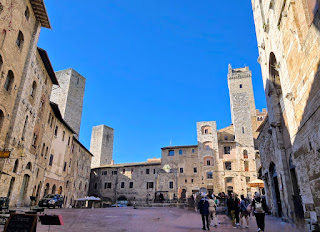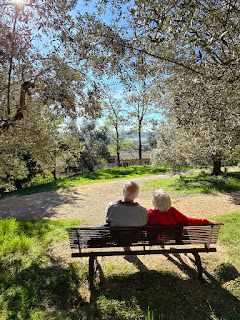SAN GIMIGNANO
Twin towers
San Gimignano is another Italian hill town encircled by walls. The town radiates from its triangular Piazza della Cisterna, a piazza lined with medieval houses.
The old cistern/well
Beautiful house facades
It has a skyline of medieval towers, for which the town is beloved.
Towers seen from the piazza
Who doesn't love a good crenallation?
Bastion at wall's main portal
Pointy skylines were the norm in Tuscany in the Middle Ages, when feuding noble families ran the hill towns (think Montagues and Capulets). Each family had its own private army that would periodically battle things out from the protection of its respective family towers. While some were built as a refuge against attackers, others were empty, chimney-like structures built only to boost noble egos (not unlike the McMansions of today).
Florence ruled in the 14th century, asserting their power over the local nobles by ordering them to lop off their towers. But for whatever reason, some of San Gimignano's original skyline was allowed to remain intact. Today, 14 of its original 72 towers still stand.
Walking throughout the town, crenallated and spikey shadows fall across streets and buildings, creating a truly delightful setting.
On Piazza del Duomo stands the town's Romanesque cathedral. Sienese Gothic art from the 14th century lines the nave with parallel themes — Old Testament on the left and New Testament on the right.
Twin towers
Nearby is a pair of towers that have stood side by side for more than 700 years. These sisters are empty shells, built by the Salvucci family simply to show off. At the time they were built, no one was allowed a vanity tower higher than the old City Hall's 170 feet. So the Salvuccis built two 130-foot towers — totaling 260 feet of stony ego trip. Local guides claim that Minoru Yamasaki, the architect of New York City's World Trade Center, was inspired by these twin towers.
Alessandra è brava -- my new friend
The Duomo di San Gimignano is a 12th-century church with frescoes by Ghirlandaio in its Santa Fina Chapel.
Some photos as I walked through the town:
And now, the food....
Mariella's is still the best
Ribollita served with raw onions
Vincenzo and I liked it.
Joe had a San Gimignano specialty pesto, made with almonds
Our cuisine crew. Delightful folks.
The piccola cucina. Walls and ceilings covered with satisfied diners' notes, many of which included skilled artistic sketches.
Charcuterie remains, Joe, and Vernaccia
Notes detail
Known for its ribollita, finocchiona, prosciutto toscana, and Vernaccia wine, Vincenzo found a restaurant that could deliver the best of it all.
A pocket-sized place, Rigoletto did not disappoint! We finished with cantucci fatta in casa and a beautiful Vin Santo -- for dunking, of course!
Random San Gimignano photos follow:
In memory of Inga, played by Teri Garr
Sense of High
Tether horses
Iron gaslight
And rounding a corner, a guy sits on his terrazza, tuning a harp.
Walls:
Arched view
Crenallated shadow with fancy brickwork, arched window, iron lamp
Serra
Walk like a Sicilian
(Cue up Bangles tune)
I saw various animals shapes in this door knocked. What do you see?
Flowers in full bloom on a
hot November day
Olive tree and hillside
Sky blue intensified in window reflections
San Gimignano, dear, quaint, charming towered town, it was delightful to meet you!
Now on to:
VOLTERRA
Volterra is a charming Tuscan borgo, noted for its production of alabaster and rich Etruscan history, but recently was made famous for being one of the settings for Twilight. It is yet another walled town.
It is said that Volterra is the city of the Volturi, an ancient dynasty of very powerful vampires, who for over twenty-five centuries have consecrated the city as a place of legends and mysteries. The ancient seat of the council of vampires is said to be located in Volterra: it is here that one passes from the 'New World' to the 'Old Continent'.
Its culinary notoriety includes chestnuts, truffles, mushrooms and game; ingredients often prepared with ancient recipes, although new chefs bring a modern touch.
Unfortunately, this is the town in which we spent the least amount of time. I'd like to come back and have an overnight stay sometime. It's utterly charming.
The other thing is that we spend a LOT of time in churches in Italy; they are not just houses of worship, they are also art, history, and geology museums. The Cattedrale di Santa Maria Assunta, or Duomo di Volterra is indeed another splendid example of these things, but I was a little disappointed I couldn't ramble amongst Etruscan archeological sites or see where the vampires congregate. But, as I said, we were short on time. I'd like to return, although it's not an easy place to get to. Even within the town, streets are almost vertical. The roads leading up to it are tight and steep.
I leave you with my short photo journey of the lovely Volterra:
Original ancient city portal within the walls
Alabaster store... there really were not many souvenir shops (I say this as a 'plus'); this is more of a legit store for purchasing alabaster products, anything from chandeliers and sconces to chess
boards and earrings.
During our hour or so transit to the airport, Alessandra made a point to say she wants to stay in touch with us, and please visit her in Torino. Once at the airport, we hung out at the gate, meeting four adorable young women who are traveling to Brindisi. They're in their last year at
liceo, all planning to attend university next year. Medicine, law (this perked up Joe's ears), economics, physics. Ever vivavious Marisa spotted them, saying how lovely they are, and one gal thought she was beckoning her over. She and Marisa chatted for a moment, and then the young woman asked if we're from Sicily -- she could tell by Marisa's accent. That strangely comforted me.
It was a late flight, and we arrived at Biancavilla's border around 11:15 pm. Vincenzo asked, "Ho fame? Volete panini o tavola calda?"
"Sì, ma come volete. Si uguale."
Yes; we're hungry, and either panini or arancini fare are good.
And because he knows every corner and where to find something at every hour, Vincenzo drove to the spot that used to be Costa Bar (where they always thought I was from France) but is now called Bistrot, and is ten times beautified from how Costa had it. It's also open all night, as they have a market in the wee hours for nurses, delivery drivers, passers-through.
Vincenzo decided we should have both, so he ordered panini (mortadella, galbani, sottocetta) and arancini (pistacchio) to take home. We had a really great end of the night dining experience, and turned in just before one in the morning.
It's been a fast and furious trip, and though we're not lovers of organized tours, this one was interesting and fun. Without anyone else speaking English, we were forced to develop an ear and practice our Italian voices, all of which improved dearly.
I'm grateful for this group, their conviviality, and the burgeoning friendships.
Now time to sleep fast!
Buonanotte.

























































































Comments
Post a Comment